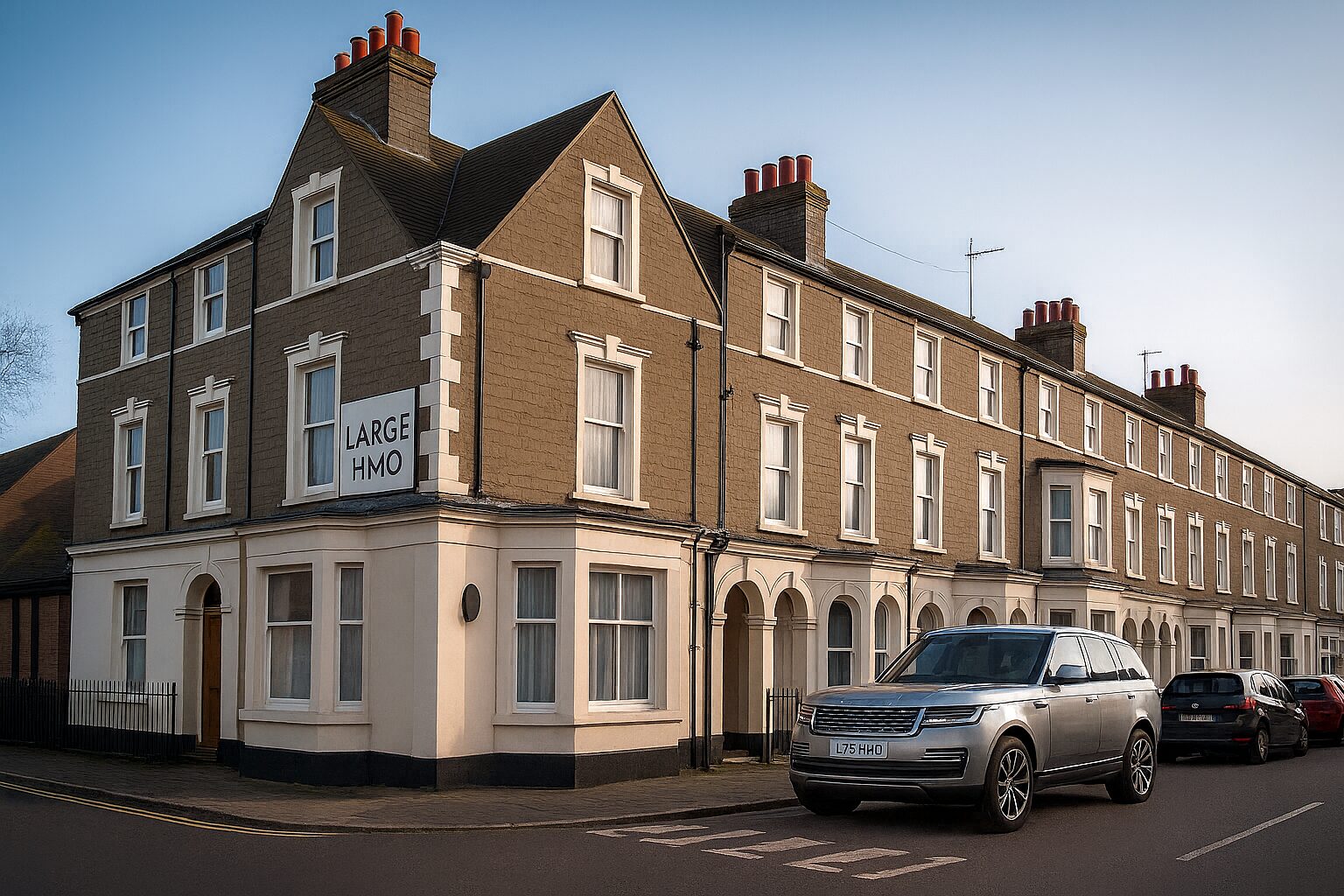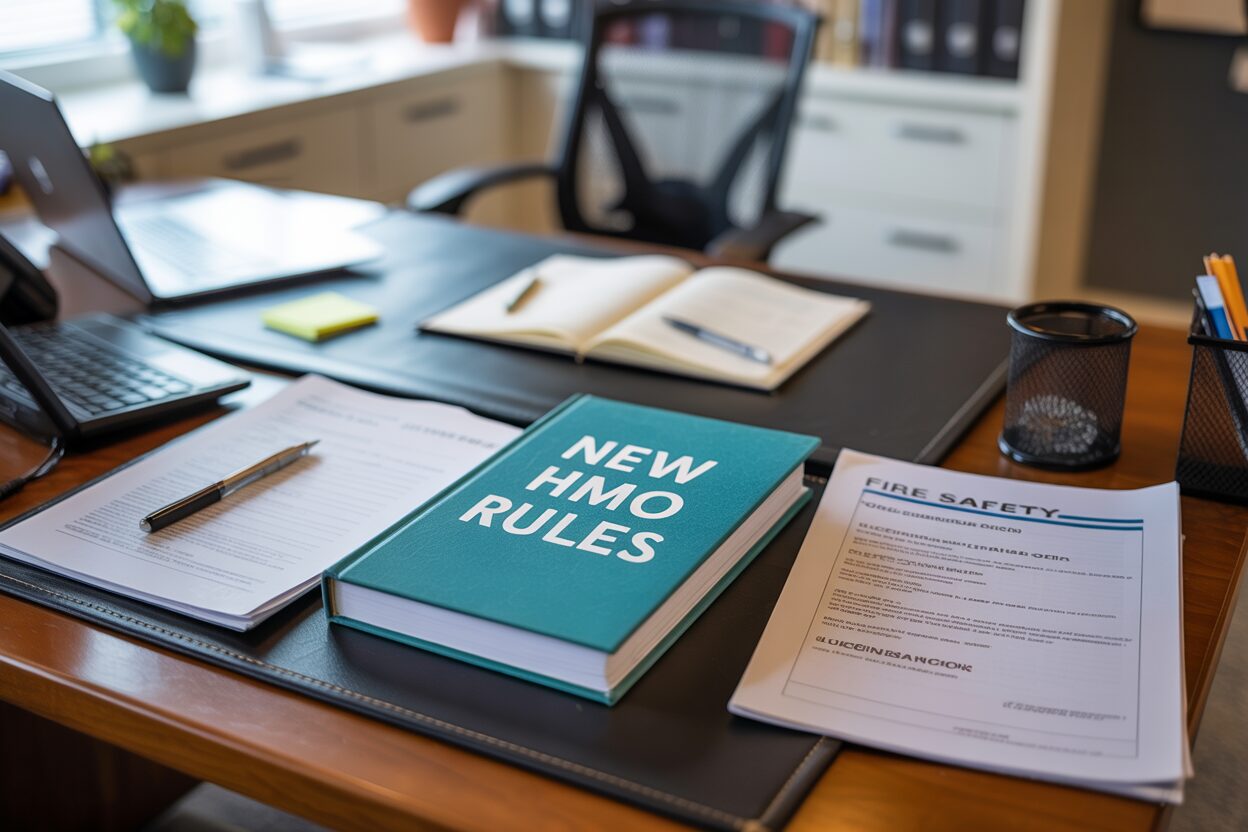
Under the Housing Act of 2004, a House in Multiple Occupation (HMO) is a building (or part of a building) that three or more people forming two or more households occupy. Although the statutory definition has been known for over two decades, there is still a degree of confusion among landlords on the difference between a standard HMO and a large HMO.
In this article, find out what a large HMO is, which ones need an HMO licence and when you need to apply for planning permission.
What is a large HMO?
In England and Wales, a large HMO is legally defined as a property rented to and occupied by five or more people from more than one household if the following applies:
- The tenants share toilet, bathroom or kitchen facilities (in most cases)
- At least one tenant pays rent, whether directly or an employer paying for them
A household is a single person or a group of family members living together. For example, in a student HMO, the five households are five students from different families. In a resident-landlord situation, the owner occupier lives with three or more lodgers from different families (one or two lodgers does not count as an HMO under landlord laws).
HMO properties are usually houses or self-contained flats. However, they can also be conversions of commercial builds to HMOs and purpose-built blocks of flats. Examples from our own portfolio include:
- Italian restaurant and tattoo studio into a 10-bed large HMO
- Conversion of a former NatWest bank into a mixed-use HMO and office building
- Nightclub into a 12-bed large HMO
- Large former bed and breakfast into a stylish HMO
Tenants don’t always share facilities in an HMO. Examples include converted buildings with bedsits, council-declared section 255 HMOs and section 257 blocks. These types of HMO are rare so, for the purposes of this article, we’re focused on more common house and apartment arrangements.
When do large HMOs need an HMO licence?
All large HMOs (five or more tenants) need to apply for and secure a mandatory licence. You need to apply to the council or local authority.
If you hold multiple HMOs, each needs a separate licence. Licences are per property. If you own and operate an unlicensed HMO which should have a local authority licence, this is a criminal offence. You may face a civil penalty of up to £30,000 or prosecution with an unlimited fine.
Your tenants can also seek a Rent Repayment Order for up to 12 months’ rent and you cannot validly serve a section 21 notice while unlicensed.
How do I apply for a large HMO licence?
To register for mandatory licensing, follow these steps:
- Completed application form with your contact details and licence fee
- Electrical Installation Condition Report (EICR)
- Updated gas safety certificate
- Safety certificates for all electrical appliances (some councils require PAT testing)
- A fire risk assessment and a fire alarm commissioning/test certificate
- Proof of ownership or the right to rent the property
- General information on how you’ll manage the property
- A copy of the proposed tenancy agreement (or agreement in place if you’re renewing your HMO licensing)
The exact documents councils need vary by authority so check what they need beforehand.
If your council requires HMO planning permission for your property, send them the planning decision notice and Building Regulations completion certificate.
Why might my HMO licence be turned down?
An HMO inspector will visit your premises and meet with you and/or your managing agent. You can nominate a managing agent who is responsible for the day-to-day management and compliance of the property.
They may refuse a licence if your property does not meet the standards set out in Licensing of Houses in Multiple Occupation (Prescribed Description) (England) Order 2018. One reason could be that bedrooms and communal areas in your HMO fail to meet the certain standards required by law on minimum room sizes. Another could be poor fire safety provision. For example, a lack of smoke alarms or emergency lighting where an escape route is long, complex and lacks access to outside light.
You (and your managing agent, if you have one) also need to pass a “fit and proper person” test. If you have a criminal record or have been convicted of fraud, dishonesty and breaches of landlord law or housing law, the council is likely to deem you as not a suitable person and refuse your application. You can appeal against a council decision however there is no guarantee you’ll overturn it.
Do I have to apply for planning permission for my large HMO?
If you wish to turn an existing house or flat into a large HMO with five or six occupants, you don’t need planning permission. This is because this is a permitted development right. However, you will need planning permission if:
- The area is subject to an Article 4 Direction.
- There is an existing planning condition on the property that requires you to obtain express planning permission before any HMO use. This could be, for example, a restriction to H3 use unless the council agrees otherwise.
You always need to seek planning permission for a large HMO. There is no permitted development right that allows you to convert an existing building into a sui generis class. Sui generis is the use class for large HMO accommodation with seven or more occupants.
HMO Architects: the UK’s leading large HMO investor-architect practice
The returns landlords, investors and developers make on HMOs are impressive. Even after management fees and the significant effort and cost of conversion, large HMO yields far outstrip traditional buy-to-lets and holiday cottages. The rules governing HMOs are more complex but with the right professional partners, you can design, license and operate large HMOs compliantly while protecting your returns.
HMO Architects is the UK’s leading partner to investors, developers and landlords. We help clients at all stages of their development, from helping identify a feasible first target purchase through to building a strong multi-property HMO portfolio.
Some of our recent success for clients include:
- Norman Road, Portsmouth (7 units): We converted a terraced house into a standout seven-bed Sui Generis HMO in a highly popular residential area. Property value increased from £350,000 to £750,000 and our client’s rental income soared from £900pcm to £5,500.
- Gunhild Close, Cambridge (6 units): We re-planned a family home into a six-bed HMO with all en-suites and tea-points, adding a loft dormer for head-height and upgrading thermal performance to achieve a better EPC rating. The value of the property increased from £85,000 to £260,000 and rent from £350pcm to £2,500.
- Soham Road, London (5 units): We delivered a budget-tight C4 HMO in an Article 4 area by smart space-planning and light refurb works. This led to the creation of five compliant rooms with high appeal to professionals and students. The property, once worth £450,000, is now worth £750,000 and attracts £4,500pcm rent, up from the previous £1,600.
Get in touch to discuss your project:
- Investment strategy calls: Speak directly with Ryan Windsor. Our Investment Direct has consulted on over 2,200 projects for clients. He started building his own extensive property portfolio when he was 17 so he’s been on the journey you’re on.
- Feasibility study: Get pre-buy and design feasibility studies from Architect Director Giovanni Patania and his team. Find out if your project is viable or whether you should spend your time finding the next opportunity. We can provide a full feasibility report for your project, too.
- End-to-end service: Access a range of key services under one roof. We provide architecture design and planning to building regs and interior design. The experts you need are all in one place.
- Wider network: Plug into our pool of trusted professionals. Access experts ranging from specialist builders to property finance brokers when you need them.
Check out our detailed HMO legal FAQ and find out more about the true cost of unlicensed HMOs on our website.
View our range of development finance case studies to see how we’ve helped clients turn their ideas into sound investments. Read customer stories on HMO, flat, holiday let and housing projects.
For further information, call 01223 776 997 or email us direct.
Frequently asked questions
What planning class is a large HMO?
If a large HMO has five or six tenants, it is a Use Class C4. If it has seven or more tenants, it is sui generis.
What is the difference between a large and small HMO?
The difference between a large and small HMO depends on whether you’re approaching it from a licensing or planning perspective. From a licensing perspective, a “small HMO” is a property with three or four tenants from two or more households. Any more than that and it’s a large HMO. From a planning permission perspective, a “small HMO” has up to six tenants from two or more households. Any HMO with more tenants is a large HMO.
Is a 3 bedroom a HMO?
The three-bedroom property where two or more households pay rent can be an HMO.
What are the two types of HMO?
The two types of HMOs are “large HMOs” and “small HMOs” but their definition differs. From a planning regulations perspective, a “large HMO” is a property with seven or more tenants forming two or more households. From a licensing perspective, a “large HMO” is a property with five or more occupants from two or more households.
Ryan Windsor, Development Director and co-founder of HMO Architect, brings over 15 years of specialised experience in HMO development to the table. Having consulted on nearly 2,200 projects, Ryan is a highly seasoned HMO landlord with a vast and influential property network. He began his real estate journey at just 17, rapidly amassing a wealth of experience that sets him apart in the industry. Beyond his professional successes, Ryan is passionately dedicated to giving back, leading numerous charitable initiatives that make a meaningful impact on local communities.




